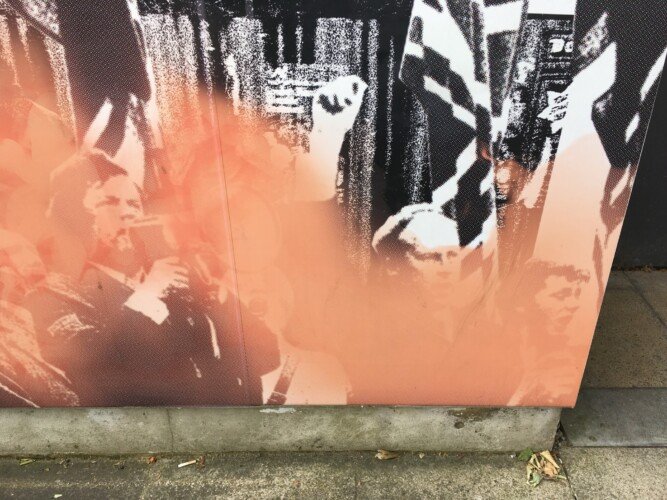Exclusive: Black Goldsmiths lecturer resigns over mural featuring Neo-Nazi
A lecturer has resigned from Goldsmiths University of London, after the institution failed to remove a mural which depicts a Neo-Nazi who attacked him in 1992, leaving him with a severe stab wound and broken arm.
Paul Halliday, 63, of South-west London, is calling for an independent investigation into the mural on a public facing wall at Goldsmiths, following his resignation as course leader on the Photography and Urban Cultures MA on July 4.
The Goldsmiths ‘Battle of Lewisham’ mural was unveiled on October, 26, 2019, following 18 months of public consultation, to remember when the far right attempted march through the area but were outnumbered by crowds of anti-fascists in 1977.
The mural is a collage that includes an image of John Tyndall, former head of the National Front (NF) and the British National party (BNP) who has been convicted of domestic terrorism offences.
A spokesman from Goldsmiths said: “Following extensive discussion by the mural’s advisory group it was considered appropriate to include all those involved so the full story can be told of a significant event in the history of Lewisham.”

Tyndall, who died in 2005, operated his political machine from his mother’s home in South London where his beliefs of “unashamed white supremacism” sought a Britain from which black people and Asians would be “humanely but compulsorily repatriated”.
In 1992, Tyndall was directly involved in a racist attack that left Mr Halliday with a serious stab wound and fractured arm as he accompanied anti-fascist campaigners in the Chicksand Estate, just off Brick Lane, in Bethnal Green, east London.
Mr Halliday said: “Seeing the image brought back what I can only describe as the most appalling flashbacks.
“I walked away from the best job I’ve ever had. I had to draw a line.”
Mr Halliday raised a complaint against the mural on August, 24, 2022, through Prevent – the government agency monitoring domestic terrorism – and copied Goldsmiths senior management into the email.
Prevent advised Mr Halliday to raise his concerns with Goldsmiths, but when no action was taken he contacted the Met in January 2023.
Goldsmith University and College Union (GUCU) published a motion in support of an independent investigation, and asked the college to remove the images from the mural in March 2023.
During this time, Mr Halliday was diagnosed with work-related Post Traumatic Stress Disorder (PTSD), as a result of the images of Tyndall.
He said: “This has caused so much damage to myself and my family – I’ve had periods where I haven’t slept more than an hour a night because of the flashbacks.

“Goldsmiths have a responsibility to safeguard students and staff – objectivity and neutrality is not involved.”
Despite recommendations from the university’s occupational health advisor that the mural was triggering Mr Halliday’s PTSD, Goldsmith’s refused to take action.
He resigned just weeks before violent riots spread across the country after three young girls were killed in a stabbing in Southport on July 29. False claims were spread online that the perpetrator was an asylum seeker, but violence continued even after the lies were disproved.
Mr Halliday said: “We have now seen just how serious far-right public disorder can be.”
During the creation of the mural, about 100 members of the public and Goldsmiths staff and students contributed to the consultation.
A spokesman from Goldsmiths said: “Respondents said that the inclusion of far-right marchers should be done in a sensitive way to ensure the work does not celebrate these groups or individuals. These wishes were reflected in the final design.
“Since its installation in 2019 the mural has received very positive feedback and continues to raise awareness of this key moment when people stood together and stopped fascism.”
But, Mr Halliday described the research process for the mural as “deeply flawed”.
He said: “It’s completely disconnected from local history and experience.
“The design incorporated images from five white photographers but the image is related to the experiences of black communities.
“Goldsmiths has taken no responsibility for providing a platform for convicted domestic terrorists. If people say this causes harm there has to be a mechanism to help that.”
Despite his resignation, Mr Halliday said he continues to support Goldsmiths’ students, staff and communities.
He said: “It has been an incredible honour to have taught and researched with so many outstanding colleagues and students.
“I will continue to support the college and wider community in combating extremism.”
Pictured top: Paul Halliday with his camera in South London (Picture: Mercedes Baptiste Halliday)
